Key takeaways:
- Market cycles consist of distinct phases: accumulation, uptrend, distribution, and downtrend, emphasizing the importance of emotional resilience during downturns.
- Understanding factors such as economic events, regulatory changes, and investor sentiment can significantly impact trading strategies and decision-making.
- Analyzing historical data and using technical analysis tools can help predict market trends and improve investment timing.
- Diversification and strategies like dollar-cost averaging can mitigate losses and provide a more stable investment approach during volatile periods.
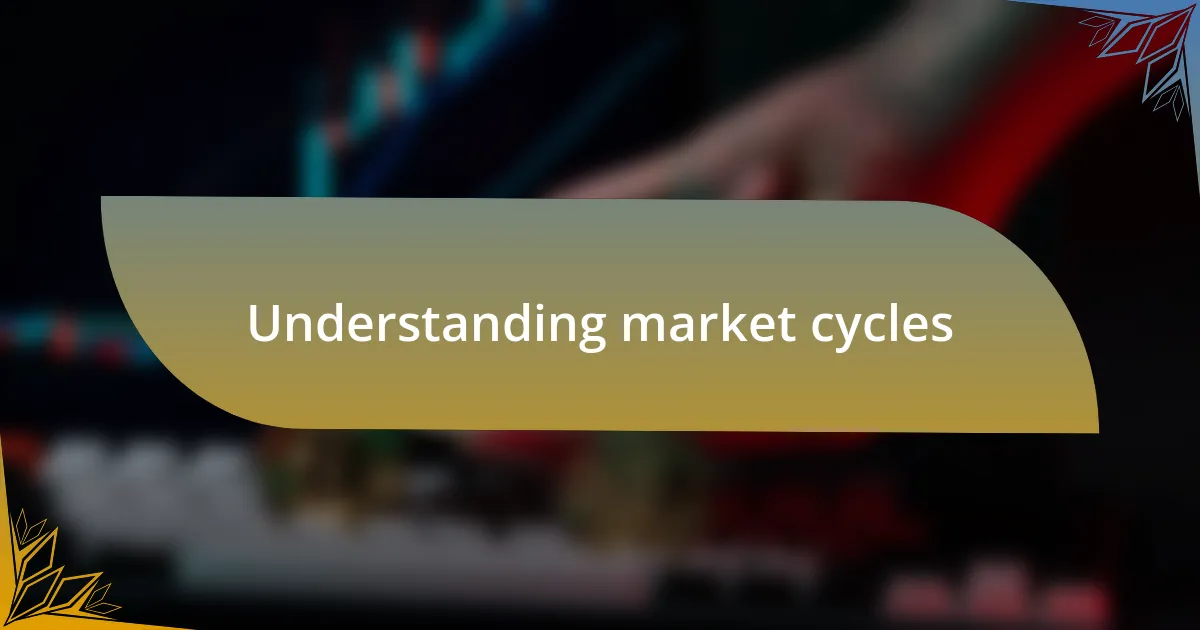
Understanding market cycles
Market cycles in cryptocurrency are essentially the ebb and flow of price movements, driven by a mix of sentiment, technology, and macroeconomic factors. I remember vividly when Bitcoin hit its all-time high in late 2017. The euphoria was palpable, and it was tempting to get swept up in the excitement. But understanding that this peak was part of a longer cycle helped me maintain perspective.
Every cycle consists of distinct phases: accumulation, uptrend, distribution, and downtrend. Reflecting on my own experience, I often found myself questioning the timing of my decisions. Was I buying at the right moment? Did I sell too soon? Recognizing these phases allowed me to approach trading more strategically, rather than purely emotionally, and it’s an insight I’d recommend to anyone navigating this volatile landscape.
I’ve also learned that it’s not just about the numbers. Emotional resilience plays a key role during market downturns. Have you ever felt that sinking feeling as prices dropped? In those moments, understanding market cycles helped me remind myself that downturns are often the precursor to the next wave of growth. Each phase serves a purpose, and acknowledging that can transform how you experience the journey.
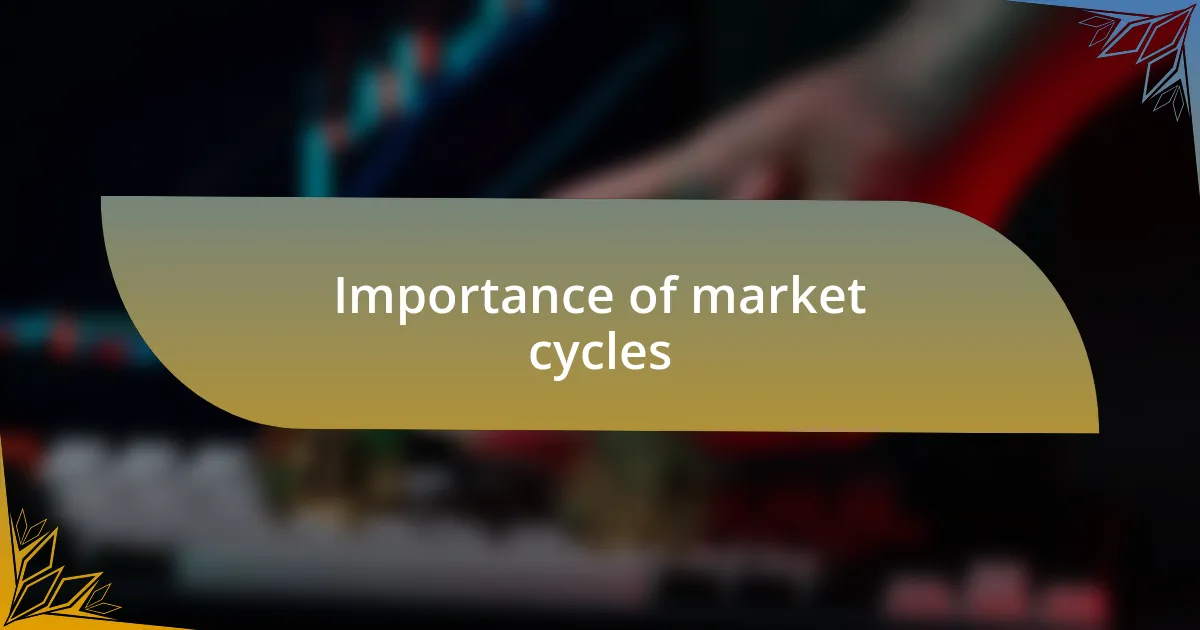
Importance of market cycles
Understanding market cycles is crucial for any cryptocurrency investor, as they highlight the rhythm of price movements influenced by collective behavior and market sentiment. I’ve often found myself pondering how easily my emotions could sway my investment decisions; during steep declines, it felt as if the market would never recover. Recognizing that these downturns are often just a prelude to a new uptrend has been key in helping me maintain a long-term perspective.
When I first ventured into cryptocurrency, the idea of market cycles was almost alien to me. It wasn’t until I experienced a significant drop that I truly grasped their importance; the panic I felt was overwhelming. But after riding the waves a few times, I learned that each cycle is an opportunity for savvy investors to capitalize on market mispricing. This understanding allowed me to reframe my anxiety into a strategic approach, guiding my decisions toward growth rather than fear.
Another lesson that stands out is the significance of timing within these cycles. In my early days, I often jumped in and out of positions based on fleeting trends, resulting in missed opportunities. Now, I realize that patience is a critical virtue; aligning my investments with the cycle’s natural flow has not only rewarded me but also provided a sense of peace. How often do we forget that while the market may be volatile, its cycles are predictable? Embracing this pattern has truly changed the way I interact with the crypto market.
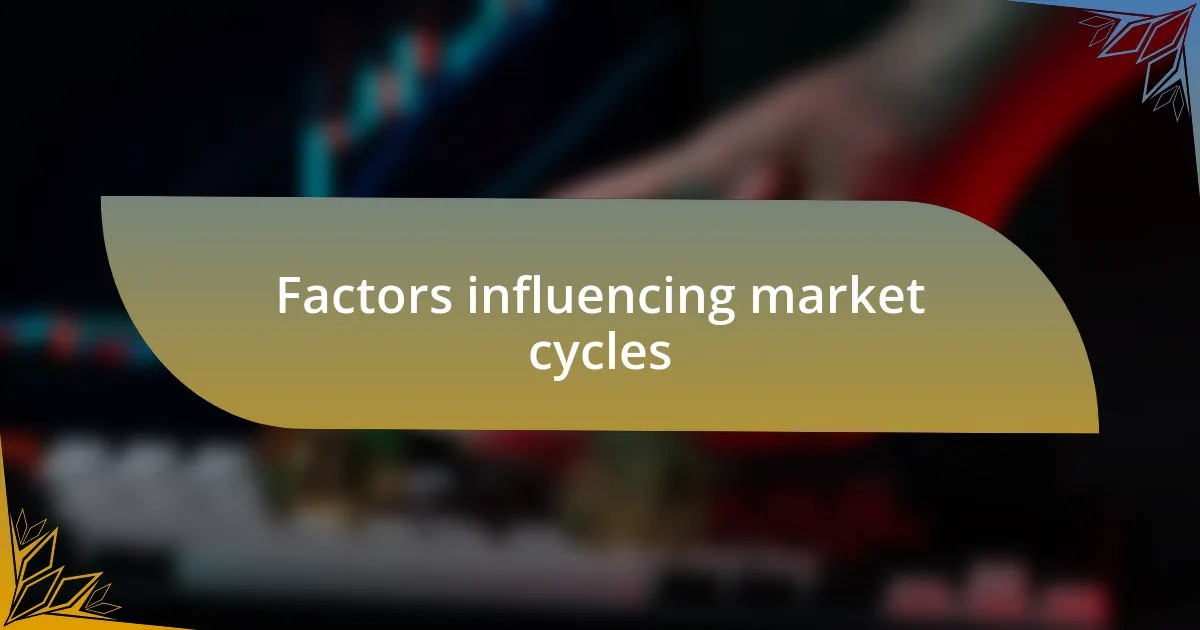
Factors influencing market cycles
Understanding the factors influencing market cycles has been a game-changer for me. Economic events, regulatory changes, and technological innovations often trigger shifts in the market. I remember the uncertainty I felt during regulatory announcements; I quickly learned that even a single piece of news could send prices tumbling or soaring, reminding me of the unpredictable nature of cryptocurrency.
Investor sentiment plays a huge role as well. There were times when I got swept up in the euphoria during market peaks, only to be met with a harsh reality later. The excitement felt almost contagious back then; how could I not follow the crowd? However, I’ve since realized that this collective behavior often leads to overvaluation, making it essential to gauge sentiment critically rather than relying solely on impulses.
Finally, supply and demand dynamics are fundamental in influencing cycles. I vividly recall how scarcity during a significant halving event made me rethink my strategies. The thrill of watching prices rise due to increased demand and limited supply taught me that these cycles aren’t just about trends—they’re about fundamental market forces. Have you ever measured your decisions based on these principles? For me, it became clear that understanding these elements is crucial to navigate the volatile waters of cryptocurrency investing successfully.
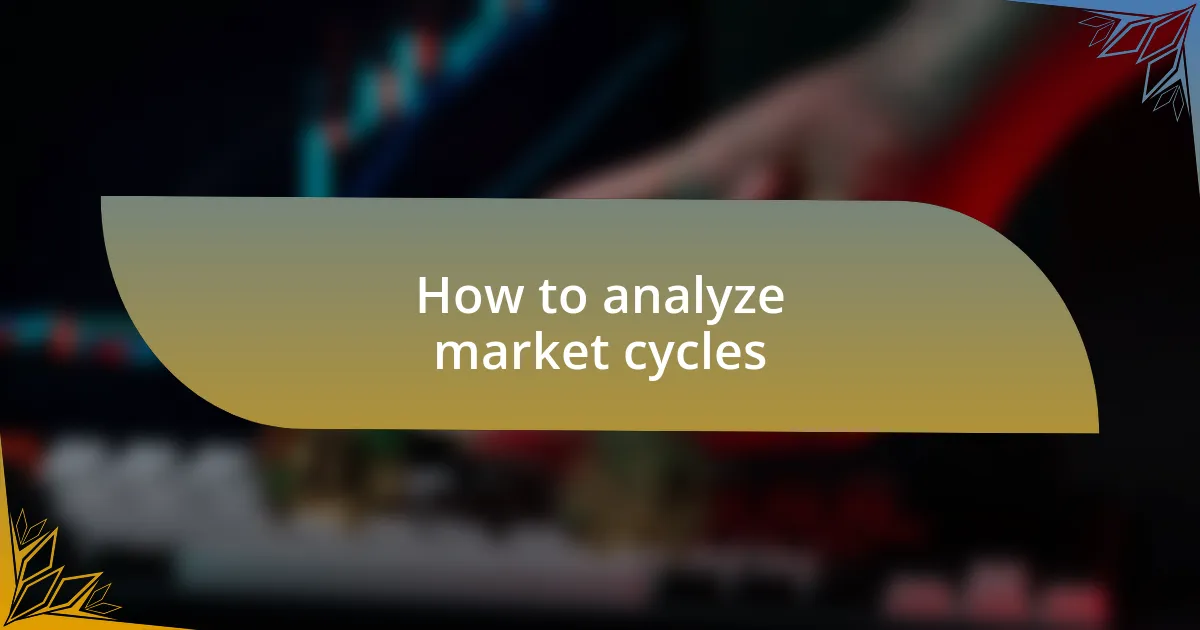
How to analyze market cycles
Analyzing market cycles involves recognizing patterns that frequently repeat themselves in the cryptocurrency landscape. I remember my initial confusion trying to make sense of seemingly random price movements, but I eventually discovered that looking at historical data provides valuable context. Have you ever found yourself stuck trying to predict what happens next? I learned that studying previous market peaks and troughs often unveils rhythm and repetition that can guide future expectations.
To dig deeper, I suggest using technical analysis tools like moving averages and support-resistance levels. When I first experimented with these tools, it felt like uncovering hidden truths in the chaos. Watching how different indicators aligned during market shifts helped me anticipate price changes more effectively. It’s not just numbers; it’s about reading the market’s pulse—what patterns resonate with your observations?
Lastly, keeping track of macroeconomic indicators can enhance your cycle analysis. I’ve found it incredibly insightful to intertwine crypto movements with broader economic events. For example, during periods of rising inflation, I observed how Bitcoin’s appeal increased as a hedge against traditional markets. Have you considered how external factors might influence your investment decisions? It’s a reminder that understanding the bigger picture can provide significant advantages when navigating market cycles.

Personal experiences with market cycles
I remember vividly my first encounter with a market cycle after investing in cryptocurrency. It was a thrilling rollercoaster—rapid gains followed by sharp declines left me feeling both exhilarated and anxious. Reflecting on that experience, I realized how crucial it is to develop emotional resilience. Have you ever felt the urge to sell during a downturn, only to regret it later? Learning to stay level-headed was essential for my long-term investment strategy.
As I navigated through subsequent market cycles, I encountered a moment of clarity when prices were at an all-time high. I had made significant gains, yet I felt a nagging worry. Should I sell and cash out, or hold for what could be even bigger returns? I chose to sell part of my investment, which not only provided me with profits but also taught me the importance of taking profits along the way. It’s a delicate dance between fear and greed, isn’t it?
Looking back, there was also that time when I ignored the warning signs during a downturn because I felt emotionally attached to a particular asset. That led to a frustrating loss that could have been mitigated with more discipline. Now, I always remind myself to treat market movements as data rather than dictating my emotional state. How do you handle the emotional rollercoaster of investing? It’s all part of the journey, and recognizing these feelings is just as critical as understanding the cycles themselves.
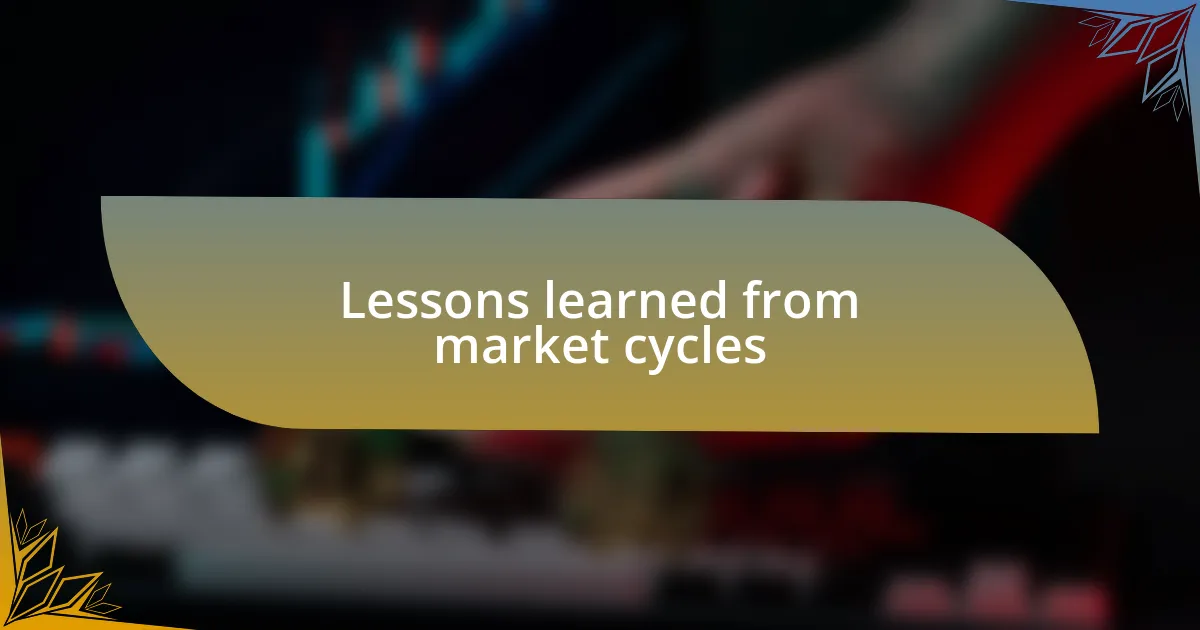
Lessons learned from market cycles
While experiencing market cycles, I learned that timing the market is nearly impossible; it’s more about time in the market. There was a phase when I thought I could predict the highs and lows, but every attempt backfired. Have you ever found yourself chasing a trend, only to watch it slip through your fingers? The lesson here is simple: consistency and patience often yield better results than short-term speculation.
Another pivotal moment came when I saw peers panic selling their assets during a sharp market decline. I resisted the urge to follow the crowd, and that decision paid off handsomely. It became clear that understanding market cycles isn’t just about price movements; it also encompasses the psychology of fear and panic. How do you maintain your resolve when everyone around you is acting hastily? I found that strengthening my knowledge proved invaluable on those nerve-wracking days.
Moreover, I discovered the importance of diversification during market downturns. When a single investment takes a hit, it can feel devastating. I remember spreading my investments across various cryptocurrencies and traditional assets, which softened the blow during difficult periods. This experience taught me to embrace a well-rounded investment approach. Have you considered how diversification might help you weather future market cycles? It certainly has shaped my strategy moving forward.
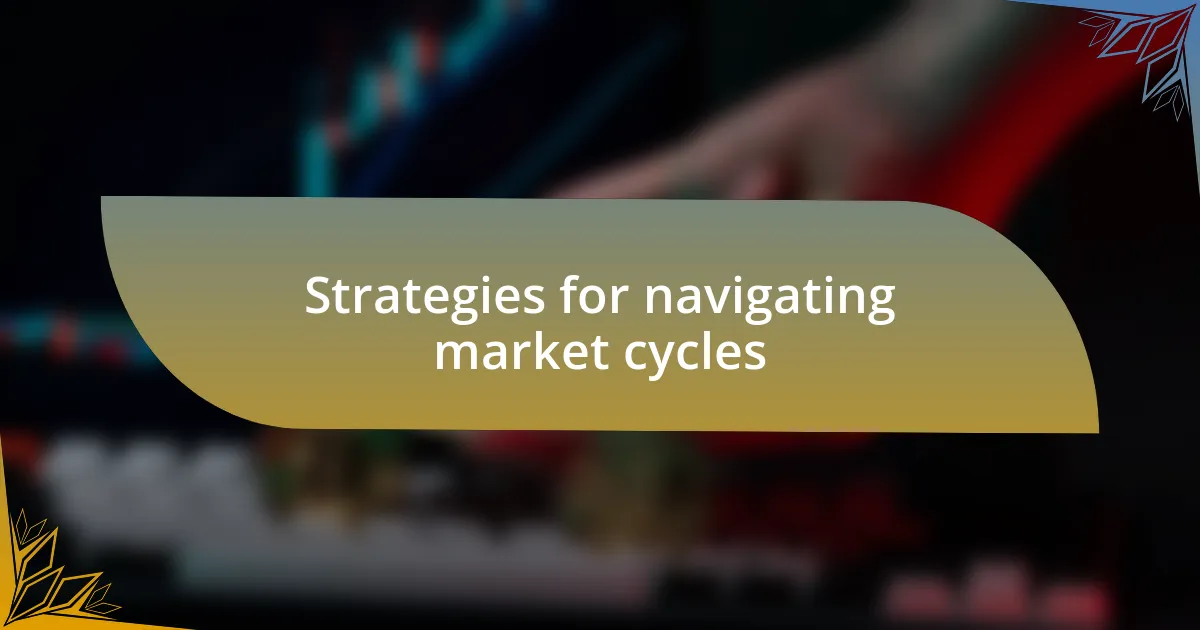
Strategies for navigating market cycles
Fostering a strong understanding of market trends can be a game-changer. I remember a time when I invested heavily right before a market dip, feeling confident in my choices. After that experience, I learned to approach investments with a thorough analysis of market indicators—not just gut feelings. Have you ever felt that rush of excitement, only to be met with a sudden downturn? Investing based on research and not just emotions can pave the way for more rational decision-making.
Another strategy that I found immensely beneficial is setting clear entry and exit points for my trades. Early on, I often entered the market impulsively, driven by momentary spikes in excitement. Now, I carefully establish targets ahead of time and stick to them, allowing me to enjoy profits while managing emotions that often cloud judgment. Does that resonate with your experiences? By having a plan, I avoid the urge to deviate and can approach trading with a level head.
Finally, dollar-cost averaging has been a lifeline during volatile times. I vividly recall how, during downturns, I maintained my investments rather than selling in a panic. I chose to invest a fixed amount regularly, regardless of the market conditions. This not only reduced the impact of volatility but allowed me to accumulate assets at a lower average cost. Have you considered this approach? Embracing dollar-cost averaging has taught me that consistent investment can outweigh the noise of market fluctuations.